#technew
Text
Elon Musk Announces xAI: Building the Ultimate Alternative to ChatGPT
xAI, the brainchild of Elon Musk, is a cutting-edge AI company that brings together a team of exceptional talent from prestigious organizations such as DeepMind, OpenAI, Google Research, Microsoft Research, Twitter, and Tesla. The company aims to push the boundaries of artificial intelligence by leveraging their expertise in projects like DeepMind's AlphaCode and OpenAI's GPT-3.5 and GPT-4 chatbots.
0 notes
Text
#artifact all you need to know about upcoming #AI powered #news feed #app | #upcoming #socialmedia app | #instagram founders to launch new app | #personalised news feed app Artifact | #tech news 2023 | Upcoming social media app?
1 note
·
View note
Text

Does a USB drive get heavier as you store more files on it?
Nope. Paradoxically (and theoretically), the more you save on a flash drive, the lighter it gets.
USB drives use Flash memory, which means the the ones and zeros of the data are stored on transistors.
When you save data, a binary zero is set by charging the float gate of the transistor, and a binary one is set by removing the charge.
To charge it, we add electrons, and the mass of each electron is 0.00000000000000000000000000091 grams.
This means that an empty USB drive (which mostly holds zeros) weighs more than a full USB drive (which has ones and zeros). Add data, reduce the weight.
#usb charger#usb port#usb cable#usb#technews#minimal techno#technoblade#technology#tech magic#tech memes#science and technology#science acumen#scientific illustration#scifi#science#the glass scientists#mad scientist#computer science#computer accessories#mobile application development#mobile app development
997 notes
·
View notes
Text
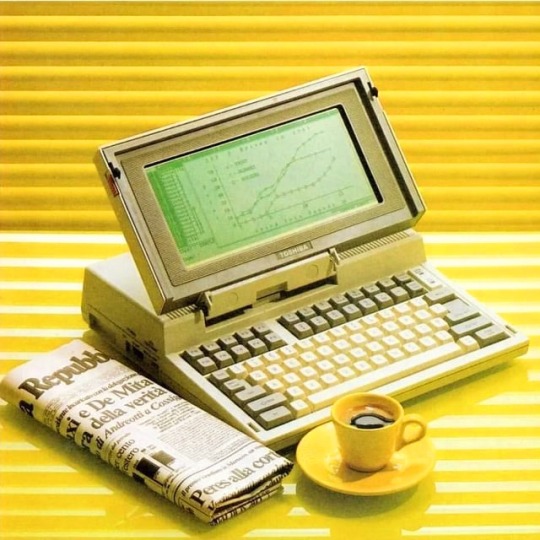




🇯🇵 Unveiling the Toshiba T1100: A Journey into the Dawn of Portable Computing!
💻 In the early 1980s, a revolutionary device emerged, transforming the landscape of personal computing forever. The Toshiba T1100, released in 1985, marked a significant milestone in the history of portable computers. The Toshiba T1100 has subsequently been described by Toshiba as "the world's first mass-market laptop computer".
🌐 The Toshiba T1100 was among the first truly portable computers, designed for professionals and enthusiasts seeking computing power on the go. Weighing approximately 4.1 kilograms (9 pounds) with its lead-acid battery, this innovative machine provided users with unprecedented mobility.
⚙️ Equipped with an Intel 80C88 processor running at 4.77 MHz and boasting 256 KB of RAM, the Toshiba T1100 offered impressive computing capabilities for its time. Its 9.6-inch monochrome LCD screen provided a crisp display, while the detachable keyboard enhanced usability.
💾 The T1100 introduced several innovative features, including a built-in 3.5-inch floppy disk drive—a rarity at the time—which allowed for data storage and transfer with ease. This model also featured MS-DOS as its operating system, providing a familiar computing environment.
📈 The Toshiba T1100 set a new standard for portable computing, demonstrating the feasibility and practicality of laptops for business and personal use. Its success paved the way for subsequent generations of laptops, influencing the evolution of mobile computing worldwide.
👨💻 For professionals in various industries, the Toshiba T1100 represented a game-changer, enabling efficient data management, word processing, and spreadsheet tasks on the move. Its portability and functionality empowered users to work beyond traditional office environments.
🌟 Today, the legacy of the Toshiba T1100 lives on in the sleek, lightweight laptops and notebooks that have become indispensable tools for modern professionals and digital nomads. This groundbreaking device remains a testament to Toshiba's commitment to innovation and excellence in the field of computing. The Toshiba T1100 remains an iconic symbol of the dawn of portable computing—a chapter in the ongoing story of technological progress that continues to shape our digital world.
#old technology#techtime chronicles#companies#tech#technology#old tech#technews#information technology#corporations#electronics#toshiba#t1100#toshiba t1100#laptop#laptops#portable computer#computer science#computing#computers#computer#hardware#software#1980s computers#1980s#innovation#made in japan#japan#retro tech#tech review#pc
136 notes
·
View notes
Text
ATTENTION IF YOU HAVE AN INSTAGRAM ACCOUNT
Meta (the company that owns Instagram and Facebook) is rolling out in more countries its update that steals the photos and texts that you upload to feed its AI.

(*26th June 2024. I have my phone in Catalan and Instagram, which is not fully available in Catalan, must have picked up the date from my phone and mixed it in the English message)
I have a private account and an open account, and I've only gotten this notification on my open account, so I'm assuming private accounts are safe for now (but considering Meta's history of human rights violations, privacy violations, lies, and doing everything they can for money, I'm not sure I trust them on this or that it will stay like this).
As the text says, you have the right to object to the content you uploaded being used for their AI. To request your content not be included, you have to send them this form (this is the hyperlink you get when you click "right to object" on the notification):
However, even if you send them this, Meta has to manually approve each application to decide whether or not they grant you the opportunity to opt out of their AI.
I've already received the email saying my objection has been approved and it will be applied "from now on". I don't know what legal basis they use, so if you want to copy what I said, basically I said I have photos of heritage sites that are copyright protected with a license where we are allowed to take photos and post them without a profit, but they're not allowed to use them in a commercial way such as AI training. It worked, so you can say the same if you want.
Something else to keep in mind:

If you have a friend whose account is open, let them know about this. Not only so that they can protect themselves, but also so that they don't upload photos of you and your face is used to generate AI images.
I have to say tho, even with my objection request being approved, I don't really feel safe in Meta services anymore, because I don't trust it. I think it's a good moment to delete our Facebook and Instagram accounts regardless.
55 notes
·
View notes
Text
does anyone know of any reasonably priced headphones that will actually stay on my apparently small head?? This is kind of infuriating. They’re all “adjustable” but only from large to even larger. What the fuck help :/
#tech#technology#tech help#technology help#tech review#product reviews#product recommendations#sony headphones#sony#headphones#adhd autistic#autistic rant#autistic community#autistic thoughts#sensory sensitivity#sensory issues#sound sensitivity#i love music#musicblr#tech geek#tech gadgets#techreview#technews#techcore#music community#music tumblr#advice request#please advise#mutual aid#mutual aid request
16 notes
·
View notes
Text

Your brain could be the next computer mouse! 🖱🖥😂
Like what you see? Then give us a follow! We promise not to control your mind… yet! 😉

#funny#funny memes#funny post#satire#humour#haha#funny shit#just for fun#hilarious#just for laughs#just for you#edenin's echo chamber#humor#comedy#jokes#parody#mouse#tech#technews#elon musk#neuralink#brain implant
11 notes
·
View notes
Text
10 apps that Apple Vision Pro needs right now
Let’s explore 10 future ideas for Apple Vision Pro that will inevitably be created and monetised despite all critisism and fears of the decline of the Apple Vision Pro market
AR-Couturier. The concept is based on a flexible measuring tape that extends from the fingertips of both hands (flexible finger roulette), or alternatively, you can set a starting point with a finger and measure non-linearly, thus measuring hips, chest, shoulders. Developers should consider making the polyline smoother and more accurate for measurements. Glasses would make this tool work better and more precisely than apps that often misjudge planes. This idea of a virtual measuring tape for body measurements is highly innovative and could revolutionize the fashion and custom clothing industry.
AR Fitness. Exercise in a unified AR space styled after different immersive worlds. Individuals or groups from different corners of the world can exercise together, choosing rooms based on interests, goals, and countries. There’s an option to choose trainers (for an additional fee) or exercise with prerecorded workouts (for introverts). Combining physical exercises with AR in various styled worlds is an excellent way to make fitness more exciting and accessible globally.
Virtual Confession App. This app is modeled after Russian Chatroulette, where random people communicate, but with a crucial difference: it offers an immersive space design using AR glasses. Imagine choosing a therapist’s chair, a monastery cell, or something else for your dialogue with another person. Participants not only talk but can also set tasks for each other and complete them. For an additional fee, professional psychologists/therapists can be involved, and various consultation rooms and meditation sessions can be created. This concept of random communication with elements of confession and task completion is unique and can create a highly intriguing and emotional user experience.
AR Anti Couch Potato. A humorous motivator for particularly lazy people. Put on the glasses, and a motivator (with a selectable avatar) compels you to do something (through threats or gentle manipulations). The essence of such a motivator is to synchronize with your notes/reminders and any documents, analyze your records and tasks, and make you complete them. Developers need to consider how to protect themselves from user criticism, perhaps by ensuring that each user provides documented consent in advance not to be offended by the motivator to avoid AR abuse. This idea is particularly original and addresses the current issue of motivation. Integrating AR with personalized reminders and documents to stimulate activity could genuinely help people overcome laziness and become more active.
AR Empathy Simulator. The app of the century, capable of training and teaching people empathy. What does it mean to be not like you, but to be someone else? The primary mission of this app is to deeply understand another individuality. Possibly, glasses are the only way to truly dive into another person’s mind. The principle of the app — wearing glasses, you transfer with granted permission into another person���s glasses or an accessible record of that person, to understand how they think and feel through an immersive experience. Potential downsides: criminals and various fraudsters might gain access, so it’s essential to carefully think through the policy and consider security measures twice.
AR Relationship App for Long-distance Couples. The goal is to maintain connections over distance. In the app, participants complete joint tasks, progress through levels, and earn rewards. A key feature of this game must be the ability for participants to see live 3D figures of each other. For instance, they can assemble puzzles, playfully interact, take quizzes, or explore AR stores and dressing rooms (a feature that bored spouses would appreciate). The main thing is that there can be many such applications, all depending on the interactivity embedded within.
AR Cards. Perhaps a less original idea, but it could gain a new twist through an immersive experience. Creating stylized spaces for playing cards in a combined AR session sounds cool, especially when players want to interact with players from different countries.
AR Mythology. Do you want to become a god while learning about myths? 3D mythology is a great way! Studying the 3D mythology of various cultures interactively and having the opportunity to play as one of the gods at the end of the course is designed for better learning material absorption. It’s particularly suitable for teenagers.
AR Chef. Imagine being given a list of dishes and shown how to prepare them in 3D models — boring? But add to this app the ability of glasses to point out mistakes in the cooking process, such as showing how to properly butcher meat or correctly measure the volume of a substance in a container (for which the correct container needs to be scanned and the right recipe selected so the glasses can determine the correct weight). This is hard to implement, but possible in the future.
AR Assistant for Combating Panic Attacks. Using AR to create an immersive experience aimed at aiding during panic attacks, combined with using smartwatches to monitor physiological parameters, represents an innovative approach to treating psychological conditions. This application should work alongside devices like the Apple Watch to track vital parameters and include a set of rules/techniques from licensed psychotherapists for specific panic attacks, as well as a calendar to monitor such states and further prognosis.
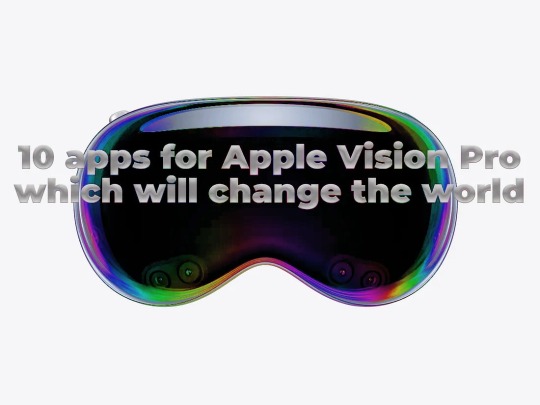
#technology#tech#technews#apple vision pro#augmented reality#apps#games#dating#dating games#empathy#culture#fashion#cuisine#ideas#immersiveexperience
12 notes
·
View notes
Text
#art#design#fyp#indeedgoodman#journal#journal entry#diary entry#diary#journaling#tech#computer#technology#technews#future
17 notes
·
View notes
Text
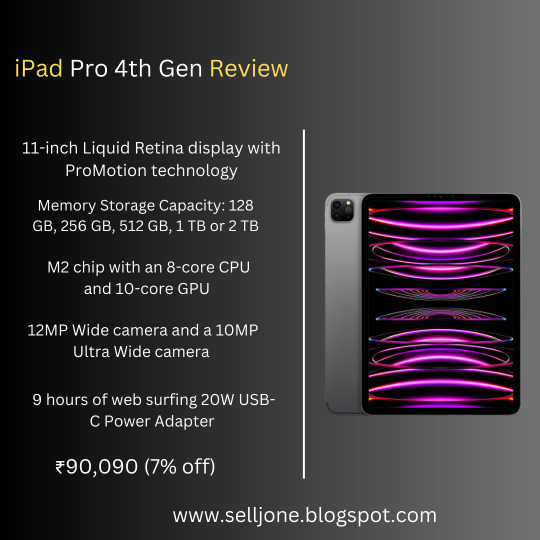
#ipad#ipadpro#4thgen#apple#gadget#technew#news#review#blog#amazon#affiliate#ios#tablet#illustration#interiors#italy#instagram#inspiring quotes#inspiration#ink#love#you#what#myself#am
0 notes
Text
Desktop portable Stargate 🌌🛸💡
Always liked the episode of SG-1 when Orlin made a mini Stargate using various parts ordered online and from Major Samantha Carter's toaster. This one at least fits in our apartment, all part of the round LCD work we are doing with the ESP32-S3.
#adafruit#arduino#electronics#opensource#opensourcehardware#espressif#esp32#espfriends#display#round#raspberrypi#ICN6211#TFT#RGB#tftdisplays#innovation#screendesign#technews#devboard#uniquedesign#screentech#gadgetlove#futuretech#pcbdesign#rgbdriver#esp32s3#ttldisplay#electronicsengineering#prototype#neopixel
32 notes
·
View notes
Text
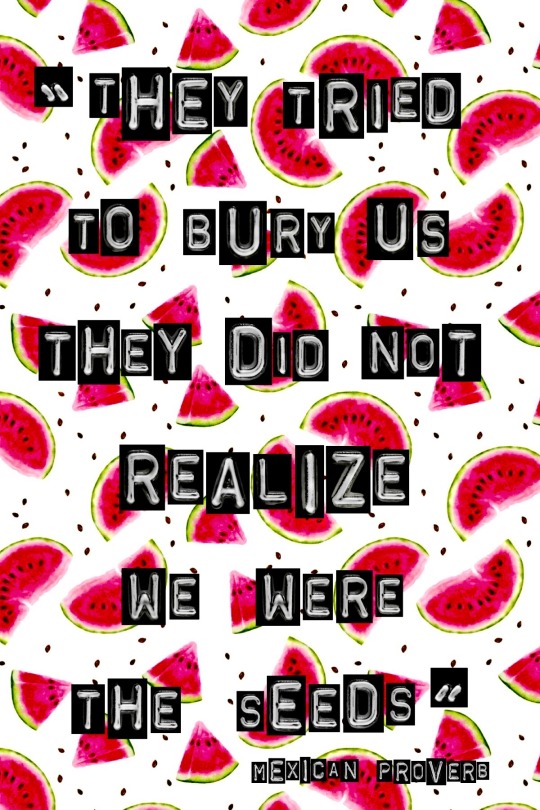






Protest art. 💖✊🏾🖌🇨🇩🇸🇩📲🗣👥👥👥
Save the JPEG. Convert it to PDF. Print it at your local print shop. Print it at your local library. Print it at work. Print it at school.
Copy it free hand.
No credit needed.
Making more soon for Sudan & The Uyghurs in China. Stay tuned. Follow for more.
#afrocentric#black ppl#black culture#black artist#black history#inspiration#freepalastine🇵🇸#free gaza#free the drc#save congo#activism#democratic republic of the congo#palestine#israel#slavery#tech#technews#colonization#anti imperialism#liberation#fight the power#capitalism#apple music#spotify#Middle East#Africa#Sudan#uyghurs#china#tik tok ban
8 notes
·
View notes
Text

Amjad Shams (19) engineering student
Vetting: new personal video stories on IG regularily
Instagram: amjed._.shams2004
Amjad is a very sweet young man, with a smile that lights up the room despite the ongoing devastation. His university was blown up & he's hoping we will help him meet the minimum requirements to escape Gaza so he can finish his education in Engineering!
He has a small goal & I hope that we can all consider giving a heart, re-sharing or donating a tiny amount to assist his border crossing!
Thank you very much for your kindness!


Small 5k goal! 81% funded!!!
Amjad's ambition is to continue his engineering degree gofund.me/d4d868c0
--------------------
#engineering student#free gaza 🇵🇸#university student#engineering#tech#technews#techreview#student life#studyblr#study blog#student#study motivation#university#university studyblr#technology#techblr#tech blog#tech bros#taylor and travis#travis scott
7 notes
·
View notes
Text
Do you know Where I Can Find Happiness?
Navigating the Path to Happiness: A Journey Within
In the hustle and bustle of modern life, the pursuit of happiness has become a universal quest. People often find themselves asking, "Where I can find happiness?" as if it were a tangible destination waiting to be discovered. However, the journey to happiness is more nuanced, often requiring introspection, mindful choices, and a recognition that joy is a subjective and multifaceted experience.

The Illusion of External Fulfillment
In a world driven by materialism and external achievements, it's easy to fall into the trap of seeking happiness in possessions, status, or external validation. Many individuals believe that acquiring more wealth, achieving certain milestones, or gaining societal approval will unlock the door to lasting happiness. However, this pursuit often proves elusive, leaving individuals feeling unfulfilled and yearning for more.
Cultivating Happiness from Within
True happiness, however, often lies within. It involves a journey of self-discovery, where individuals explore their values, passions, and innermost desires. Cultivating a sense of purpose and aligning one's life with personal values can be a powerful foundation for sustainable happiness.
1. Mindfulness and Present Living: Happiness is often found in the present moment. Embracing mindfulness – the practice of being fully present and engaged in the current experience – allows individuals to savor life's simple pleasures, fostering a deeper sense of contentment.
2. Connection and Relationships: Meaningful connections with others contribute significantly to happiness. Building and nurturing positive relationships with friends, family, and the community can provide a sense of belonging and support, enhancing overall well-being.
3. Gratitude Practice: Gratitude is a powerful tool in the pursuit of happiness. Taking time each day to reflect on the positive aspects of life, no matter how small, can shift focus from what's lacking to what is abundant, fostering a more positive mindset.
4. Personal Growth and Learning: Engaging in continuous learning and personal development can bring a sense of accomplishment and fulfillment. Setting and achieving personal goals, no matter how small, contributes to a sense of purpose and progress.
Seeking Joy in the Journey
Rather than viewing happiness as a distant endpoint, it is crucial to recognize that happiness is often found in the journey itself. Life is a series of moments, and finding joy in the process of living can lead to a more fulfilling and satisfying existence.
1. Embracing Imperfections: Accepting that life is imperfect and embracing the ups and downs allows individuals to navigate challenges with resilience. Happiness is not the absence of difficulties but the ability to find joy despite them.
2. Balancing Work and Play: Striking a balance between work and leisure is essential. Overemphasis on professional success without allocating time for personal interests and recreation can lead to burnout and hinder overall happiness.
3. Self-Compassion: Being kind to oneself is a crucial aspect of happiness. Recognizing and accepting one's flaws and imperfections with self-compassion fosters a positive relationship with oneself.
The Ever-Changing Nature of Happiness
It's essential to acknowledge that happiness is not a static state but a dynamic and evolving experience. What brings joy at one stage of life may not necessarily do so in another. Flexibility and adaptability in the pursuit of happiness allow individuals to navigate life's transitions with resilience and openness.
Conclusion: A Personal Odyssey
In answering the question, "Where can I find happiness?" it becomes evident that the journey is deeply personal. It involves self-reflection, intentional choices, and a willingness to explore the rich tapestry of human experiences. True happiness is not a destination but a continuous exploration of the self and the world, guided by authenticity, gratitude, and a commitment to living a life aligned with one's values. As individuals embark on their personal odyssey towards happiness, they may discover that the destination is not a place but a state of being found within the depths of their own hearts and minds.
Read more information to click given link:
#canada#india#tech#techcore#technews#technically#technoblade#technology#usa#100 days of productivity#seo services#seo#emailmarketing#digital marketing#smm#online marketing#kim seokjin#seonghwa#seo changbin#video games#gamedev#the hunger games#ts4 gameplay#sims 4 gameplay#tag game#gaming#videogame#gamers#steam#viralpage
12 notes
·
View notes
Text

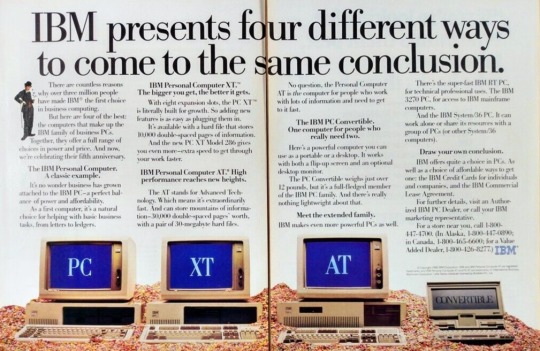


🇺🇸 Step back in time to 1986 and witness the dawn of a revolutionary device—the IBM PC Convertible. As one of the earliest portable computers, the PC Convertible marked a significant milestone in the evolution of American personal computing, offering newfound mobility and versatility to professionals and enthusiasts alike.
💻 The IBM PC Convertible represented IBM's inaugural foray into creating a portable version of its iconic PC line. It was the first laptop-style computer following the luggable IBM Portable, and notably introduced the 3½-inch floppy disk format to the IBM product line. Featuring a clamshell design this groundbreaking device set the stage for future generations of laptops. Its compact form factor and relatively lightweight made it a practical choice for on-the-go computing—a novel concept at the time.
⌨️ Unlike earlier portable computers that required external keyboards, the PC Convertible boasted a built-in keyboard, enhancing its usability and convenience.
👉 The PC Convertible came in three models: PC Convertible, PC Convertible Model 2, and Model 3. The latter two were released in October 1987 and are primarily distinguished by their LCD panels. The original Convertible used a non-backlit panel, which was considered difficult to read. The Model 2 lacked a backlight as well but upgraded to an improved supertwist panel, while the Model 3 included a backlight.
🖥️ Equipped with an innovative flip-up monochrome, CGA-compatible LCD screen, the PC Convertible offered a crisp display for viewing documents and running applications—a revolutionary feature for its time.
💾 Powered by an Intel 80C88 CPU, the PC Convertible came with built-in storage options, including 256 KB of RAM (expandable to 640 KB) and dual 720 KB 3.5-inch floppy drives, enabling users to store and access data with ease. It also featured serial and parallel ports for connecting peripherals.
🔋 Despite its modest battery life by today's standards, the PC Convertible offered respectable uptime, allowing users to work on the go without being tethered to a power source. Weighing just over 12 pounds and featuring a built-in carrying handle, the PC Convertible's battery was rated for 10 hours.
🌟 The IBM PC Convertible was succeeded in 1991 by the PS/2 L40 SX, and in Japan by the IBM Personal System/55note, the predecessor to the ThinkPad. The IBM PC Convertible left an indelible mark on the history of computing, paving the way for the modern laptops we use today. Its innovative design and practical features demonstrated the potential of portable computing, inspiring subsequent advancements in mobile technology.
#old technology#techtime chronicles#companies#tech#technology#old tech#technews#information technology#corporations#electronics#ibm#ibm corporation#ibm pc1#ibm pc#ibm pc convertible#laptops#laptop#computer science#computing#computers#computer#old computers#hardware#software#innovation#made in america#made in usa#floppy disk#thinkpad#ibm pc-line
68 notes
·
View notes